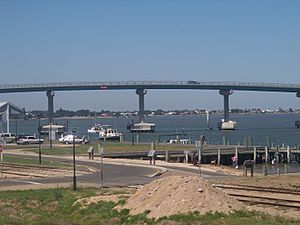Hindmarsh Island Royal Commission facts for kids
The Hindmarsh Island Royal Commission was a big investigation in South Australia. It looked into whether certain important Aboriginal women's beliefs were real or made up. These beliefs were about the land around Goolwa and Hindmarsh Island. The investigation started because of a disagreement over building a bridge to Hindmarsh Island.
Contents
Why the Investigation Started
In May 1995, news stories came out saying that the 'secret women's business' was not real. This 'secret women's business' was a set of special cultural beliefs. Five Ngarrindjeri women reportedly said they had never heard of it until Doreen Kartinyeri brought it up. In June 1995, more claims suggested that two other Ngarrindjeri people, Doug and Sarah Milera, agreed it was made up.
Because of these claims, the South Australian Government decided to start a Royal Commission. This is a special, high-level public inquiry. On June 16, 1995, Mrs. Iris Stevens, a former judge, was chosen to lead it. Her job was to find out if any part of the 'women's business' was made up. She also needed to report how, why, and to what extent it might have been fabricated.
How the Inquiry Unfolded
The Royal Commission's work faced many challenges. The women who supported the 'secret women's business' refused to speak to the Commission. Other Ngarrindjeri women, who disagreed with the claims, said they faced threats. Doug Milera, a Ngarrindjeri elder, reportedly took back his claims that the 'secret women's business' was made up.
An amateur historian named Betty Fisher told the Commission she had heard about the 'secret women's business' in 1960. However, experts on cultures from the South Australian Museum questioned if the 'secret women's business' really existed.
None of the women who said the beliefs were made up could prove it beyond their own lack of knowledge. Some even admitted they knew very little about Ngarrindjeri culture or traditions. A few said it was normal for only a few women to know secret traditions. One woman felt there was no point in living in the past, even if the claims were true. Many of these women were Christians. It was suggested that some saw The Dreamtime as a Pagan belief, which they felt was wrong.
The Commission also heard that older books by experts, like Ronald Berndt's A World That Was, did not mention secret Ngarrindjeri women's lives. Dr. Jane Jacobs, a cultural geographer, explained that these books were written a long time ago. She suggested that a male expert in the 1940s might not have learned about women's secrets. Connie Roberts, an elder who passed on the "women’s business" to Doreen Kartinyeri, explained why: You can't. You're not supposed to talk about things like that. My parents told me, only the old people used to tell certain people.
What the Investigation Found
The Royal Commission released its report in December 1995. Here are its main findings:
- The 'women's business' seemed to appear because people who opposed the bridge needed a strong cultural reason to stop its building.
- Twelve Ngarrindjeri women, who the Commission called 'credible witnesses', said they did not know about the 'women's business'.
- After looking at all the evidence, including history and expert opinions, the Commission concluded that the 'women's business' claim was made up from the start.
- The reason for making it up was to get the government to stop the bridge from being built. This would have been done under the Aboriginal and Torres Strait Islander Heritage Protection Act 1984.
- The Commission also found the 'secret women's business' illogical. It noted that existing water barriers were more impactful than a bridge would be.
After the Royal Commission's Report
The Howard Government later passed a law, the Hindmarsh Island Bridge Act (1997). This law allowed the bridge construction to go forward. In August 2001, a different court case took place in the Federal Court of Australia. Justice John von Doussa ruled that he was not convinced the claims of "secret women's business" had been made up. He rejected the developers' requests for money.


